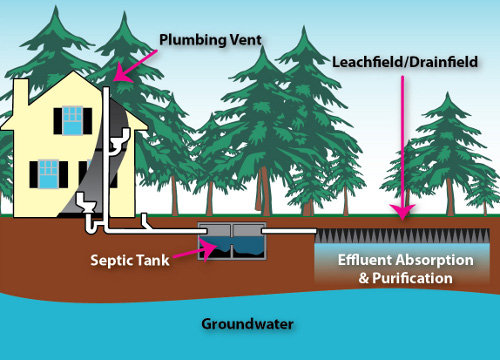HOW THE SEPTIC SYSTEM WORKS
 A Septic System is made up of four parts, including plumbing in the home, the septic tank, the drain field, or as some like to call it, the leach field and the soil and bedrock.
A Septic System is made up of four parts, including plumbing in the home, the septic tank, the drain field, or as some like to call it, the leach field and the soil and bedrock.
There is one main drain that collects from all the plumbing in your home and feeds into the septic tank. The home’s plumbing includes things such as sinks, dishwashers, garbage disposals, toilets, showers, and washing machines. Any other types of drains in the house would be included in the plumbing as well. The septic tank collects anything and everything you allow to drain from inside your home.
The septic tank is a concrete vault with a line coming in from the house and a line going out to the drain field. To determine the size septic tank needed a few things are considered; the size of the house and the expected waste volume. Obviously, the bigger the house, the larger the septic tank needed. Waste is drained to the septic tank by gravity. In some cases, a lift station or pump is used to get the waste to the tank.
The waste, once in the tank, will separate into three layers over a period of a few days. The three layers consist of the bottom being the solids know as sludge, the middle layer being the liquids, while the top layer is grease and light solids known as scum. The scum and sludge is then converted into liquefied waste. The liquid is then forced into the drain field as more and more waste from the home enters into the tank. Solids are blocked from flowing out into the drain field by baffles in the tank.
Rows of perforated pipes incased in gravel filled trenches buried a few feet below the earth’s surface make up the septic systems drain field. The drains carry the liquids from the septic tank to the end of the drain field while dispersing slowly through the gravel incased trenches and into the soil. Enzymes and bacteria begin to then break down the liquid into nutrients and base elements as it flows through the drain field’s pipes.
The final treatment occurs in the soil. The liquid flows through the drain field and seeps into the surrounding soil. The soil treats the liquids and removes harmful bacteria and viruses. Bacteria and enzymes from the soil break down and remove most of the contaminants from the wastewater before it reaches our groundwater. The system could become clogged if it has too much water/liquid causing the enzymes and bacteria to not have enough oxygen to work correctly and effectively. Once in the soil, the leftover liquids then dissipate through evaporation and filtration. It then enters the water supply.